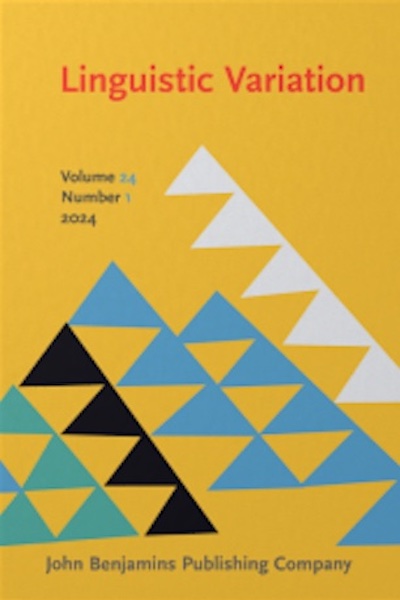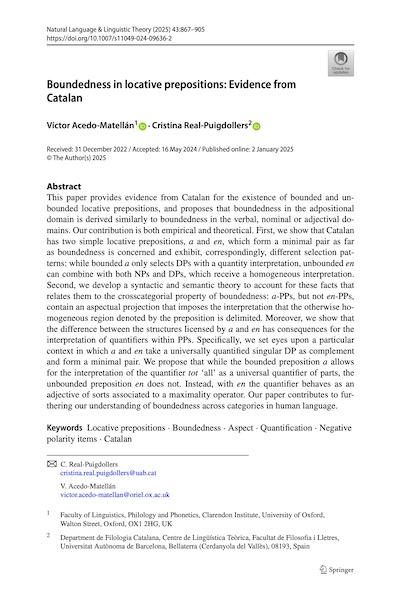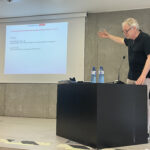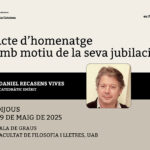15 febrer, 2024

Autors:
M.Teresa Espinal, Cristina Real-Puidgollers i Xavier Villalba
Títol:
From a movement verb to an epistemic discourse marker. The diachronic change of Spanish 'vaya'Editorial: Linguistic Variation (John Benjamins)
Data de publicació: Febrer del 2024
Pàgines: 36 Més informacióBesides its main use as a form of the movement verb ir ‘to go’, the Spanish form vaya (lit. go) is also used as a verbal discourse marker. Here we trace this transition from a purely verbal form to a discourse marker by searching a historical corpus of documents in Spanish, which reveals the increasing use over time of vaya in exclamatives to replace a presentational construction. We focus on vaya in isolation and in combination with an indefinite DP or a bare NP. We analyze the meaning of vaya as an epistemic discourse marker, by means of which the speaker expresses a judgment, a subjective epistemic and evidential evaluation of a proposition accessible from context. We postulate that these constructions sit in a Judgment Phrase at the syntactic-pragmatic interface (Krifka 2020), a position to which vaya also moves when its meaning is that of an expressive intensifier that directly modifies over one or more (contextually salient) properties of the noun contained in the DP/NP.
5 febrer, 2025

Autors:
Real, Espinal & Villalba
Títol:
Vaya in Spanish. From a judgment to a commitment markerEditorial: Journal of Historical Syntax
Data de publicació: 05-02-2025
Pàgines: 26 Més informació
Text completIn this paper we show the diachronic development of Spanish vaya, which goes from a form of the motion verb ir ‘to go’ to an epistemic verbal discourse marker (VDM) associated with the speaker's judgment regarding a proposition (e.g. ¡Vaya! ‘Wow!’ or ¡Vaya que es donoso! ‘How funny you are!’), and then to a VERUM marker (Leonetti & Escandell-Vidal 2009, Gutzmann, Hartmann & Matthewson 2017) encoding the speaker's strong commitment to the truth of a proposition (e.g ¡Vaya si se casa! ‘You bet he's getting married!’). We argue that this shift is a clear case of a run-of-the-mill process of grammaticalization involving three stages and each change corresponds to a different position of vaya in the articulated Speech Act layer advocated by Manfred Krifka (2021). When vaya expresses a subjective epistemic attitude of the speaker, it is postulated in J(udgement)P(hrase), a position associated with epistemicity and evidentiality; when vaya expresses a strong commitment of the speaker to the truth of the proposition it precedes (i.e., a VERUM marker), it is postulated in the higher Com(mitment)P(hrase). All in all, this study argues that the grammaticalization path of vaya is not only unidirectional (against previous analysis like Octavio de Toledo y Huerta 2001 and Company Company 2008), but rather obligatorily implies a bottom-up reanalysis (Roberts & Roussou 2003).
30 abril, 2025

Autors:
Acedo-Matellán & Real-Puigdollers
Títol:
Boundedness in locative prepositions: Evidence from CatalanEditorial: Natural Language & Linguistic Theory
Data de publicació: 02-01-2025
Pàgines: 39 Més informació
Text completThis paper provides evidence from Catalan for the existence of bounded and unbounded locative prepositions, and proposes that boundedness in the adpositional domain is derived similarly to boundedness in the verbal, nominal or adjectival domains. Our contribution is both empirical and theoretical. First, we show that Catalan has two simple locative prepositions, a and en, which form a minimal pair as far as boundedness is concerned and exhibit, correspondingly, different selection patterns: while bounded a only selects DPs with a quantity interpretation, unbounded en can combine with both NPs and DPs, which receive a homogeneous interpretation. Second, we develop a syntactic and semantic theory to account for these facts that relates them to the crosscategorial property of boundedness: a-PPs, but not en-PPs, contain an aspectual projection that imposes the interpretation that the otherwise homogeneous region denoted by the preposition is delimited. Moreover, we show that the difference between the structures licensed by a and en has consequences for the interpretation of quantifiers within PPs. Specifically, we set eyes upon a particular context in which a and en take a universally quantified singular DP as complement and form a minimal pair. We propose that while the bounded preposition a allows for the interpretation of the quantifier tot ‘all’ as a universal quantifier of parts, the unbounded preposition en does not. Instead, with en the quantifier behaves as an adjective of sorts associated to a maximality operator. Our paper contributes to furthering our understanding of boundedness across categories in human language.








